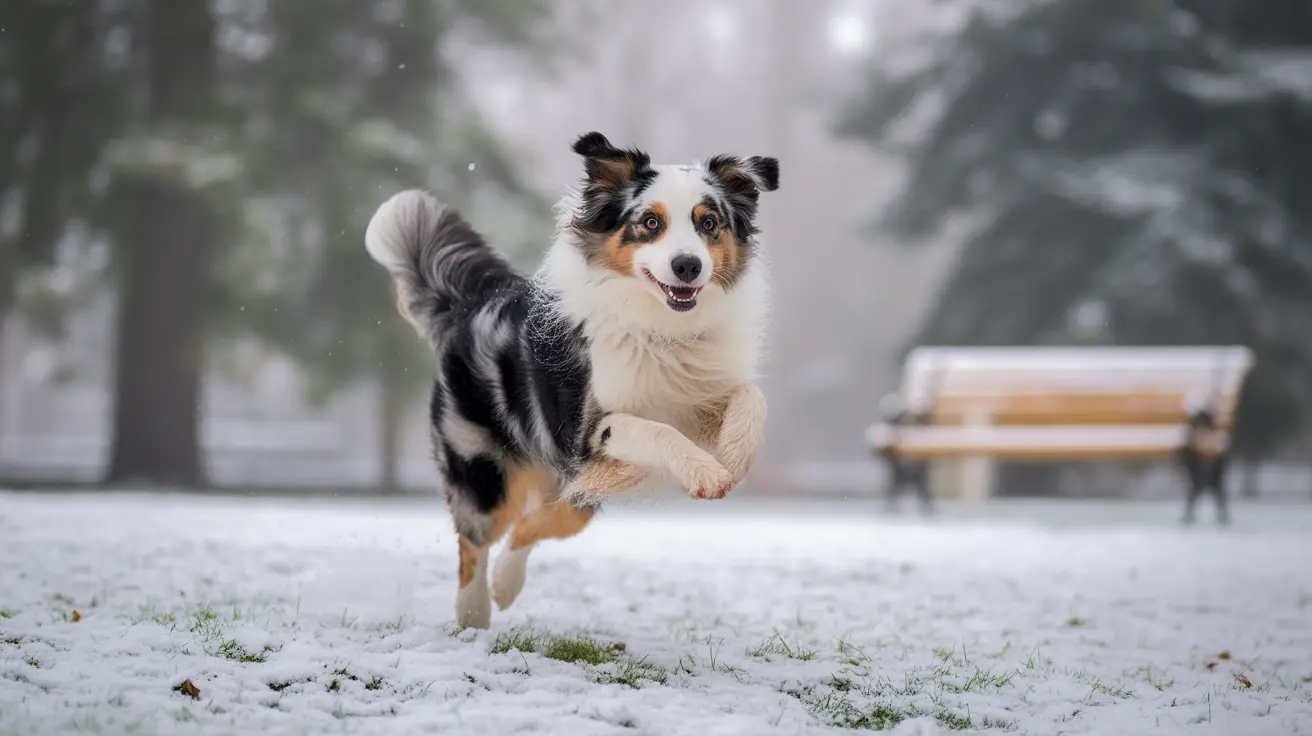Australian Shepherds are well-equipped for winter weather thanks to their thick double coat, and many of these energetic herding dogs thoroughly enjoy playing in the snow. However, their cold tolerance has limits, and owners need to understand how to keep their Aussies safe and comfortable during winter months.
Let's explore everything you need to know about Australian Shepherds and their relationship with snow and cold weather, including their natural adaptations, safe temperature ranges, and essential winter care tips.
Natural Cold Weather Adaptations
Australian Shepherds come equipped with a sophisticated double coat system that provides natural insulation against cold temperatures. The dense undercoat offers warmth, while the weather-resistant outer coat helps repel moisture and snow.
This coat structure allows most Aussies to handle moderate winter conditions quite well, though they're not specifically bred for extreme cold like some Nordic breeds.
How Australian Shepherds Typically React to Snow
Many Australian Shepherds display genuine enthusiasm for snowy conditions, often showing increased energy and playfulness when snow falls. Their herding instincts and high intelligence make them naturals at creating their own winter games.
- Bounding through fresh snowfall
- Digging and playing in snow banks
- Chasing snowballs
- Herding family members through snowy paths
Safe Temperature Guidelines
While Australian Shepherds can handle cold weather, there are important temperature thresholds to keep in mind:
- Above 32°F (0°C): Generally safe for extended outdoor activity
- 20-32°F (-6 to 0°C): Moderate outdoor activity with supervision
- Below 20°F (-6°C): Limited outdoor exposure
- Below 0°F (-18°C): Brief potty breaks only
Winter Safety Precautions
To ensure your Australian Shepherd stays safe during winter activities:
- Monitor time spent outdoors, especially in extreme conditions
- Check paws regularly for ice balls and salt exposure
- Consider boots for protection against road salt and ice
- Maintain regular grooming to prevent coat matting
- Provide a warm, dry shelter for outdoor breaks
Special Considerations for Young and Senior Dogs
Puppies and elderly Australian Shepherds require extra attention during winter months. Their cold tolerance is typically lower than adult dogs in their prime, and they may need additional protection such as:
- Shorter outdoor sessions
- Protective winter gear
- More frequent warming breaks
- Indoor exercise alternatives
Frequently Asked Questions
Do Australian Shepherds like playing in the snow, and how can I tell if mine enjoys winter weather?
Most Australian Shepherds enjoy playing in snow, showing excitement through increased activity, playful bouncing, and engagement with snow-based activities. If your Aussie voluntarily stays outside and actively plays in snow, they likely enjoy it. Signs of discomfort include shivering, lifting paws, or trying to return inside quickly.
How cold is too cold for Australian Shepherds, and what temperature range is safe for outdoor activities in winter?
Australian Shepherds are generally comfortable above 32°F (0°C). Below this temperature, monitor their behavior closely and limit exposure time. Temperatures below 20°F (-6°C) require careful supervision and shortened outdoor sessions. Consider factors like wind chill and wetness, which can make temperatures feel colder.
What are the signs my Australian Shepherd is feeling too cold or stressed in the snow?
Watch for shivering, whining, lifting paws, seeking shelter, lethargy, or anxiety. If your dog shows these signs, bring them inside immediately and warm them up gradually.
How should I care for my Australian Shepherd's coat and paws during snowy or icy weather?
Maintain regular grooming to prevent matting, which reduces insulation. Check paws after walks for ice balls and salt exposure, and consider using paw balm or boots for protection. Never shave your Aussie's coat during winter months.
Are Australian Shepherds more cold-tolerant than other breeds, or do they need extra protection in winter?
Australian Shepherds have better cold tolerance than short-haired breeds thanks to their double coat, but they're not as cold-resistant as arctic breeds like Huskies. While they can handle moderate cold well, they still need protection in extreme conditions.
Conclusion
Australian Shepherds generally enjoy snow and cold weather within reasonable limits. Their natural adaptations and playful personalities make them excellent winter companions when properly cared for. By understanding their cold tolerance thresholds and following appropriate safety measures, you can ensure your Aussie has a fun and safe winter season.
Remember that each dog is unique, so always observe your Australian Shepherd's individual preferences and adjust their winter activities accordingly. With proper care and attention, your Aussie can make the most of the snowy season while staying healthy and comfortable.






